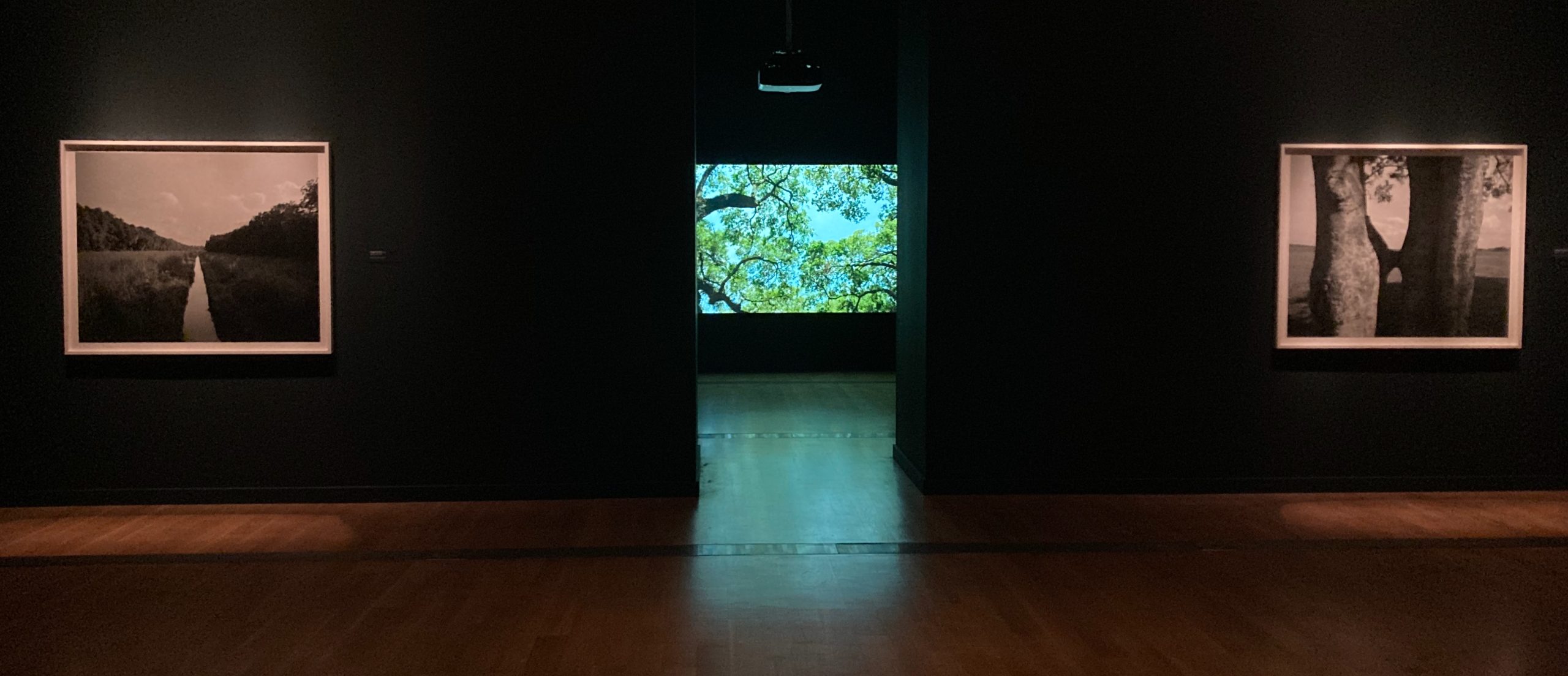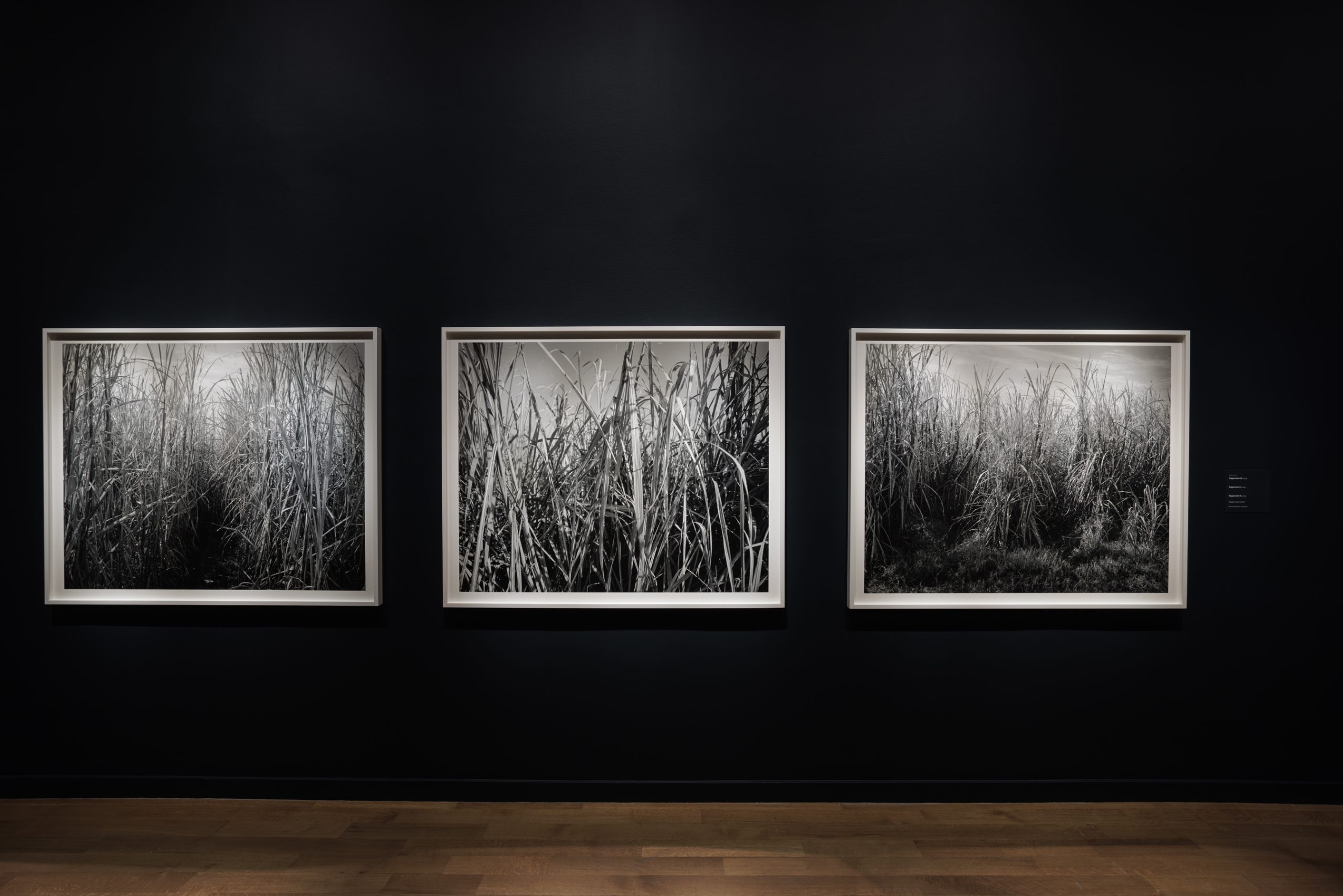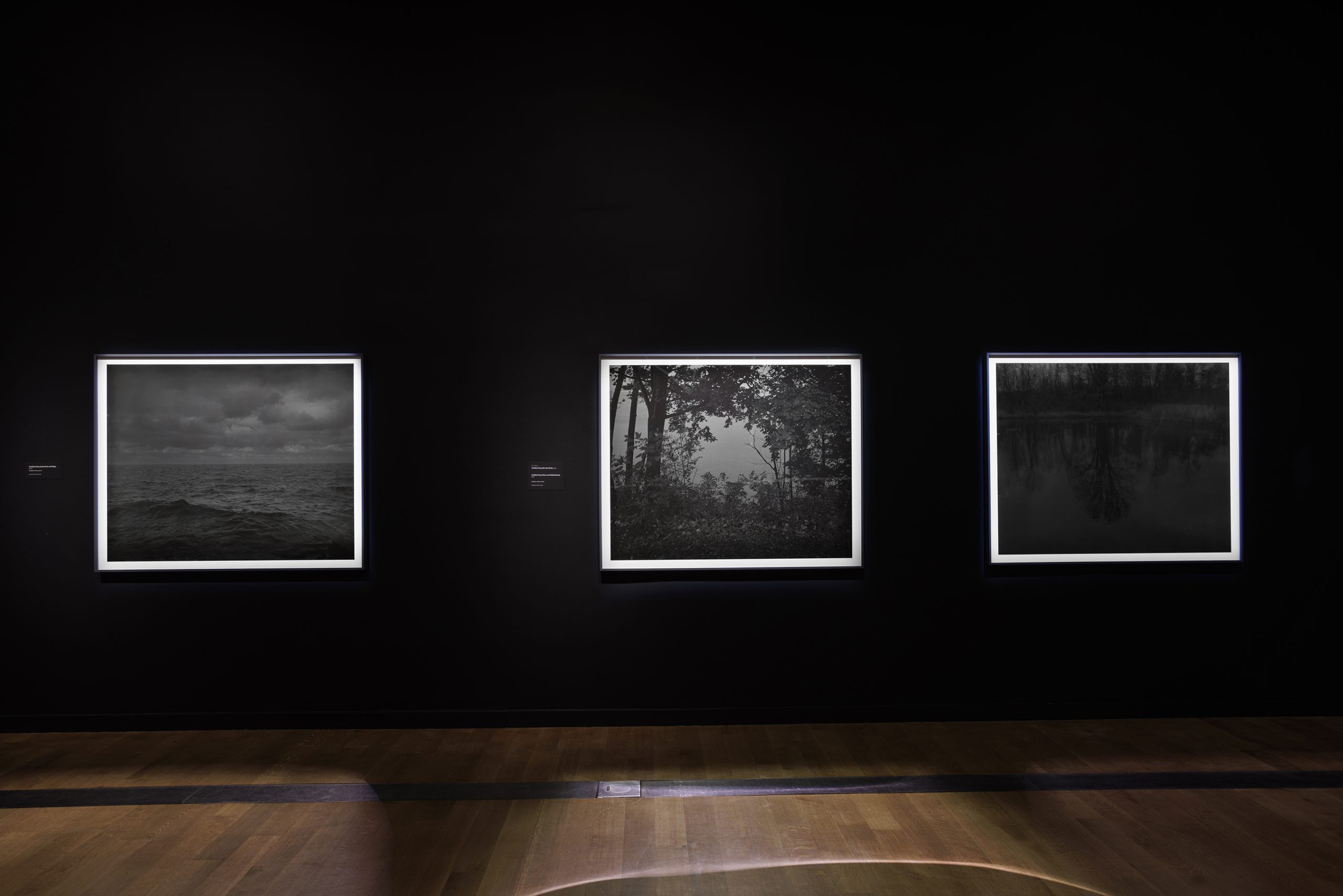Dawoud Bey: Elegy
PDF: Cochran, review of Dawoud Bey
Curated by: Valerie Cassel Oliver
Exhibition Schedule: Virginia Museum of Fine Arts, November 18, 2023–February 25, 2024
Exhibition Catalogue: Valerie Cassel Oliver, Dawoud Bey: Elegy, exh. cat. Richmond, VA, and New York, NY: Virginia Museum of Fine Arts and Aperture, Inc., 2023. 176 pp.; 11 color illus.; 61 b/w illus. Hardback $65.00 (ISBN: 9781597115643)
The question of how to make an image of the past in the present haunts the exhibition Dawoud Bey: Elegy. Bey (b. 1953), who gained acclaim in the 1980s for his photographic portraits of Harlem residents, has recently turned his camera toward landscapes, places, and spaces, omitting the human forms and urban spaces present in his earlier work. Elegy featured five of Bey’s recent projects, including two new works: a series of photographs titled Stony the Road and the video installation 350,000. Commissioned by the Virginia Museum of Fine Arts (VMFA) and curated by Valerie Cassel Oliver, Sydney and Frances Lewis Family Curator of Modern and Contemporary Art at VMFA, this display of recent work meditates on the legacy of Richmond’s role in the domestic slave trade.
The exhibition begins with Stony the Road (2023), a series of twelve large-format black-and-white photographic views of a seemingly unremarkable wooded trail. The sequence of photographs repeats the variations of plant life and topography along a winding path, which appears both recognizable and disorienting. For individuals familiar with the Richmond landscape, the photographs suggest the city’s popular riverside trails. In fact, Bey made the series of photographs along the Richmond Slave Trail, which Cassel Oliver calls the Trail of the Enslaved in the catalogue. The trail begins at the city’s Manchester Docks on the south side of the James River, proceeds west before crossing the river on the Mayo Bridge, continues through the downtown Shockoe District, and ends at the historic First African Baptist Church. Along the trail are markers that recount the shameful beginnings of the slave trade in the Virginia colony, the development of the slave trade path along the James River, and the resistance of enslaved Africans and their descendants through organized revolts and flights to freedom—including that of Henry Box Brown, who shipped himself from Richmond to Philadelphia.1 Oral histories kept by Richmond’s Elegba Folklore Society have identified the trail as the path walked by enslaved Africans to the city’s market, although the exact location of this path is difficult to confirm through written historical sources. This oral history inspired Bey’s Stony the Road, which uses photography to preserve experiences often excluded from formal histories.
Stony the Road will undoubtedly introduce many viewers to the larger domestic slave route in Richmond, yet Bey’s photographs are more affective than evidentiary. They provide no “proof” of the trail’s brutal history; they omit the historic markers; and the only sign of human activity is the trail itself—pounded ground lined with hedged brush and trees. The installation at VMFA emphasizes this ambiguity. Each photograph has a descriptive title, but the installation limits expanded interpretive labels to the gallery entrance. This decision leaves the visitor in charge of navigating the trail visually and conceptually. In other words, the decision made by Bey (and VMFA) to downplay the specificity of location pulls the Stony the Road images, and the photographic medium, away from straight documentation of seemingly familiar scenes of trails and riverfronts. Instead, the photographs push the visitor toward the realm of the imaginary, positioning them to look at—and place themselves in—the past through photographs of the present.
For visitors familiar with Richmond, photographs of Stony the Road conjure the experience of walking the James River Park trail system. Located just west of the Trail of the Enslaved, the park trails provide city residents a recreational escape during warmer months. Yet the unoccupied and shadowy trail in Bey’s photographs problematizes the benign and innocent pastime of walking along the river by emphasizing a menacing history. Before hikers and bicyclists navigated the river trails, enslaved Africans walked along the James to Richmond’s slave market.
The title Stony the Road references a line from the hymn “Lift Every Voice and Sing” (1900):
Stony the road we trod
Bitter the chastening rod,
Felt in the days when hope unborn had died;
Yet with a steady beat,
Have not our weary feet
Come to the place for which our fathers sighed?2
James Weldon Johnson’s lyrics offer a poetic context for the act of walking within the history of enslavement, emphasizing the exhaustive effort required to “walk” amid ongoing anti-Blackness—a struggle that Bey’s photographs locate on the James River and its shores. The song commemorates a continual movement “through the blood of the slaughtered” and out of “the gloomy past.” Lyrics not only celebrate an arrival at a place of liberty and possibility but also acknowledge that the walk is unfinished. In step with these lyrics, the trailhead to which the path in Stony the Road leads cannot yet be seen.
The prints on view in Stony the Road and throughout the exhibition are window-sized and placed at eye-level, creating a convincing illusion through which the viewer can imagine navigating the trail. But the pictured trail withholds any promise of conclusion or final arrival: few photographs include a horizon; the muddy river appears deep; and the winding sightlines of the trail seem unending. In Untitled (Trail and Trees), trees block the sun, and the exact time of day is unknown (fig. 1). Navigating the trail alone and in the dark triggers a certain amount of panic and urgency to leave the trail before night takes over the scene. The path is clear, but its length is unknown, its endpoint unseen.

The second gallery is dedicated to the two-channel film installation 350,000 (2023). Different views of the black-and-white film play on both sides of a projection screen hanging in the center of the room. For just over ten minutes, the film follows the Trail of the Enslaved, while a single soundtrack, composed by dancer and choreographer E. Gaynell Sherrod, provides a unifying aural experience as viewers walk from one side of the screen to the other (the soundtrack also wanders into the first gallery, merging the two bodies of work). A loud exhale begins the film, followed by the smack of bare feet against the dirt path. Twigs snap as the camera moves forward on the trail. Guttural sounds, hums, and the brushing of foliage accentuate the quickening, machine-like, one-two rhythm of footsteps.
The familiar sounds of walking a trail feel right, but their source is obscured. Some sounds that creep into the space seem out of place and time: the clop of horses’ hooves, distinct clinks of metal chains, a hollow knock of something heavy hitting a wooden structure (maybe a boat). The viewer cannot see the objects and bodies that make these sounds. Rather, 350,000 creates what composer and sound theorist Pierre Schaeffer calls an “acousmatic situation” in which the listener cannot see the sound’s source, affecting how one listens. Viewer-listeners attempt to listen through the image, hyper-aware of what they hear but cannot see on the trail, in the trees, or along the river. As haunting sounds of chains and breath fill the museum gallery in the former capital of the Confederacy, Bey and Sherrod’s visual and sonic composition offers a means of studying the echoes of the river’s antebellum past—the beats and sighs of “Lift Every Voice and Sing”—in the present.3
The transition from the quiet Stony the Road to the resonant 350,000 conditions viewers to approach the rest of the exhibition’s rooms with both their eyes and ears, to look and listen to the sounds and presences that may be unseen. This is true when encountering the photographic series In This Here Place (2019), which shows the landscapes of multiple Louisiana plantations, including Evergreen, Destrehan, Laura, Oak Alley, and Whitney. The horrors of enslavement are embedded in the series title, a passage from Toni Morrison’s novel Beloved (1987). However, the titles of Bey’s individual photographs again downplay the specificity of location as they reference common structures—cabins, trees, a ditch—rather than proper names. Although an introductory gallery label names the places that Bey photographed, to the unfamiliar viewer, these places could be any and every plantation along the Mississippi River (the only landmark named in the photograph titles). The photographs home in on the architecture of slavery rather than any one plantation, and rather than evidencing a particular event, In This Here Place visualizes an unspecified, yet haunted, landscape of cabins and sugarcane fields.
In the gallery with the fifteen photographs from In This Here Place, the sounds of 350,000 are still audible. Here, one can also see the middle screen of the three-channel video Evergreen (2021) playing in an adjacent gallery. This nearly eleven-minute, three-channel video of the Evergreen plantation features panning shots of green sugarcane, oak trees covered in Spanish moss, and aged cabins. The screen is visible through a doorway framed by black-and-white photographs from In This Here Place (fig. 2). The soundtracks of Evergreen and 350,000 play out a (sometimes overlapping) call-and-response. In this sonic blend, the sounds of the river trail transpose onto the timbre of the plantation field. For instance, in the photograph Sugarcane II from In This Here Place, a path vanishes between two dense rows of cane—the type of path situated on a plantation that would be the destination of enslaved individuals sold through Richmond’s market (fig. 3).


The bodies of the cane planters and harvesters are unseen in Evergreen, but their whispers and calls are sung by Bey’s collaborator, vocalist Imani Uzuri. A high-toned note sings “come.” Whispers of “somebody’s praying,” “just like a dream,” and “come by here” float in the air, emphasizing Evergreen’s aerial views of the plantation on a sunny day. Although we hear voices, the plantation and its cabins seem abandoned. On one screen, cabins and landscape are superimposed onto one another, creating semitransparent forms that appear as ghostly as the disembodied voices sound.
Evergreen, with its haunting and beautiful soundtrack, is visually bright—so much so that entering the dimly lit, final gallery elicits a somatic experience. Navigating the dusky landscapes in Night Coming Tenderly, Black (2017) requires an initial strain as eyes adjust to the darkness of Bey’s prints. The photographs depict wooded backyards and creeks; viewing them is like stumbling through their dark settings. Untitled #16 (Branches with Thorns) centers a thorned stem among leafless branches, a small danger to navigate at night. Printed in the distinct style of photographer Roy DeCarava, the photographs in Night Coming Tenderly, Black visualize the last lengths of the Underground Railroad near Cleveland, Ohio, on the shores of Lake Erie. This trail reaches a sequential conclusion in two of the last photographs in the exhibition. Untitled #24 (At Lake Erie) shows the edge of a wood that drops off into a vast lake that obscures the horizon—a formal element of the landscape itself and a metaphor for aspiration that is occluded or absent in the previous exhibition galleries. Untitled #25 (Lake Erie and Sky) offers a concluding image that is mesmerizing in its technical execution. Bey manages to capture the detail of a seiche in the lower left of the photograph along with peaks of smaller waves, all during the dim light of dusk or dawn (fig. 4). The collapse of night and day into a space of dawn/dusk echoes the other liminal spaces in Elegy. Bey’s photographs both image and imagine the past through a present lens that looks and listens for what is absent rather than what is present, and in this way, Elegy confronts the temporal and scopic limits of photography.

The catalogue includes expertly printed reproductions of the exhibition photographs as well as written contributions from Valerie Cassel Oliver, Imani Perry, LeRonn P. Brooks, and Christina Sharpe. Cassel Oliver’s opening essay provides an expanded meditation on the concept of an elegy, one that is not only a reflection on actual events (or what Robin D. G. Kelley might call “an intellectual history”) but also an affective expression of the present that imagines a survived past to fuel the future.4 Perry reflects on the Virginia landscape imaged in Bey’s photographs in her poetic account of Richmond’s role in the enslavement of African Americans, highlighting events of resistance like the rebellion led by a man named Gabriel (often associated with the name of his enslaver, Thomas H. Prosser). Brooks’s speculative essay imagines the connections between the present and future as survivors of an uprising of enslaved people in Louisiana are able to catch glimpses of their descendants through portal-like windows in time and space. Christina Sharpe’s contribution is a tender letter to Bey that demonstrates how one can not only see and think with the photographs but also hear and feel.
Elegy tunes viewers to absence through both sound and image. Bey’s ambitious and effective method of photographing the present to elicit remembrance of the past points to the varied ways history survives. Photography is traditionally associated with documentation, but Bey’s use of ambivalence in photographs—like interpreting acousmatic sounds from an unseen source—creates opportunity for an imaginative kind of remembrance unhindered by “gaps” that can stymie historical narratives. Instead, Bey’s projects amplify, rather than record, the absences in official histories, allowing viewers to see and hear them for perhaps the first time.
Cite this article: Sharayah L. Cochran, review of Dawoud Bey: Elegy, Virginia Museum of Fine Arts, Panorama: Journal of the Association of Historians of American Art 10, no. 1 (Spring 2024), https://doi.org/10.24926/24716839.19008.
Notes
- “Slave Trail Map,” City or Richmond, accessed February 12, 2024, https://www.rva.gov/sites/default/files/2022-06/Slave%20Trail%20Brochure.pdf. ↵
- “Lift Every Voice and Sing,” James Weldon Johnson Foundation, accessed May 21, 2024, https://www.jamesweldonjohnson.org/lift-every-voice-and-sing. ↵
- Pierre Schaeffer, “Acousmatics,” in Treatise on Musical Objects: An Essay across Disciplines, trans. Christine North and John Dack (Oakland: University of California Press, 2017), 64–70. ↵
- Robin D. G. Kelley, Freedom Dreams: The Black Radical Imagination (Boston: Beacon Press, 2002), 7 ↵
About the Author(s): Sharayah L. Cochran is a PhD candidate in art history at the University of Illinois, Urbana-Champaign

